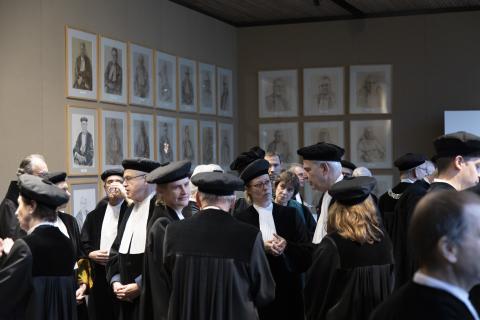Portraits 31 rectores magnifci
Portrait Hall (drawings)
Cobbenhagen Building

The portrait hall is located in Cobbenhagen Building and is adjacent to the courtyard garden. It owes its name to the portraits of the 31 Rectors Magnifci who led the university to date. The tradition of portraiture (although on the way back again) has lost importance in recent centuries with the disappearance of classical regents, but portraits continue to play a role in university circles.
The Tilburg Rectors are not painted, but drawn—a form of art well suited to a relatively young university. The portraits were drawn by three different artists. Joop Liesker (1920-2002) is the first. He was a lecturer at the tekenacademie, then located in the current Academia Building). After Liesker's retirement, his pupil Jan Asselbergs (1937-2015) took over when Gery van Veldhoven (who was both President and Rector) stepped down as Rector in 1983. In 2008 the artist Paul van Dongen (1958) took over, who for the first time also gave the chain of office a place and also used (modest) color in the portrait of Philip Eijlander. After all, traditions are there to be renewed.
A selection of portraits is on display at the exhibition, from the period when the university was still located in the city center including Thomas Goossens (the first Rector), Marinus Cobbenhagen (founding father of the university), Petrus van Berkum (first graduate, first PhD researcher), and Frans van de Ven (pioneer in the field of labor law, also a poet). The portraits that Liesker made of DBJ Schouten (the namesake of the school of the same name, which no longer exists), Cees Scheffer (Rector at the time of the first occupation of the university in 1969), Ruud de Moor (also the spiritual father of the Open University) and Ad Kolnaar (the youngest Rector, at the age of 32) date from the period from 1960. Asselbergs drew Van Veldhoven and Len de Klerk (the first non-Catholic Rector).
The portrait hall is currently being remodeled into a multipurpose room. It has traditionally been used for academic receptions and special receptions, but has also long served as a departure hall for the cortege of professors and as a somewhat more exclusive meeting room. The hall will always be open after the renovation, unlike now.
More about history and academic heritage
The Tilburg University academic heritage is a very diverse set of archives, visual materials, collections, devices, recorded stories, et cetera that relate to the history of the university.